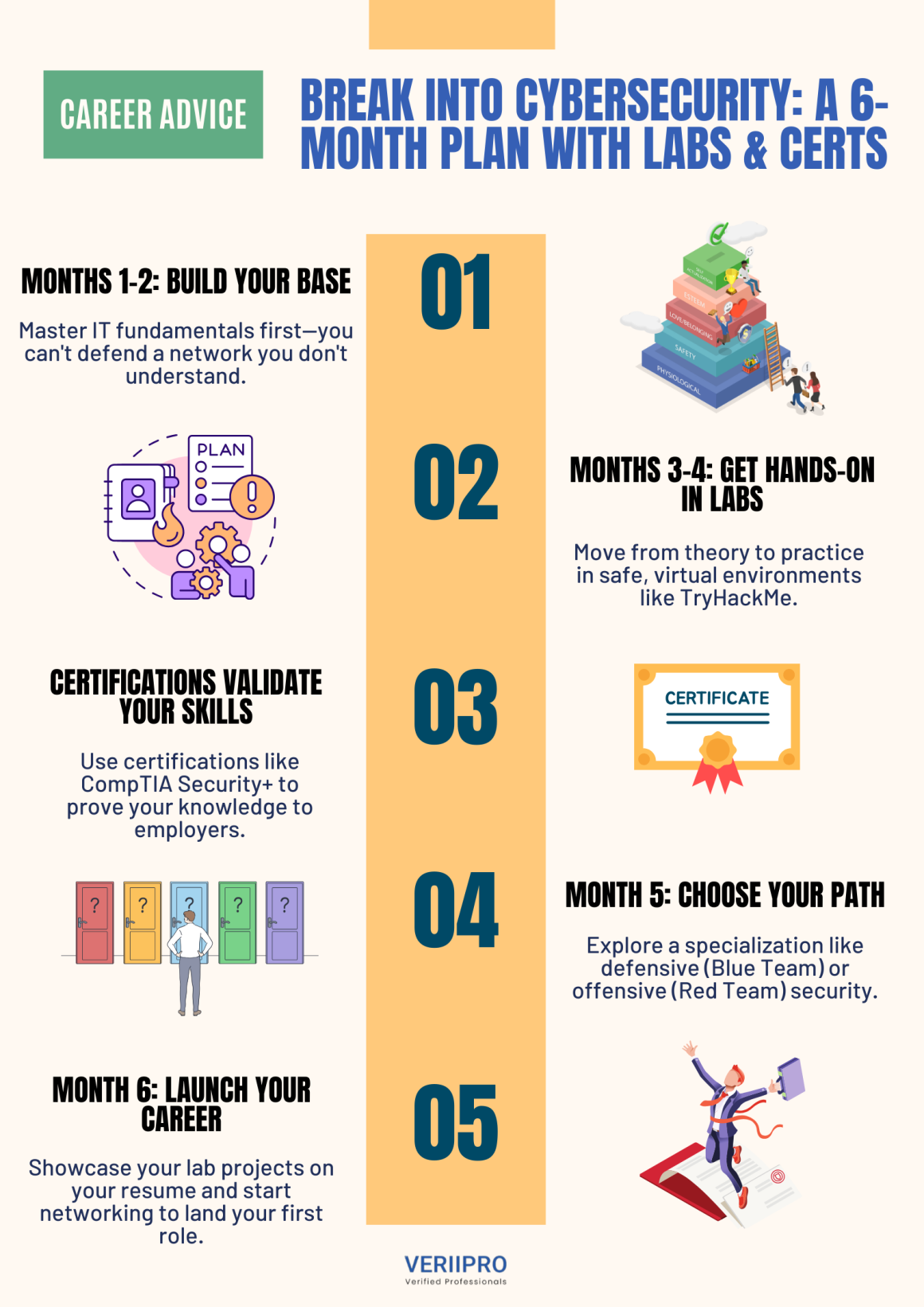Break into Cybersecurity: A 6-Month Plan with Labs & Certs
The world of cybersecurity can seem like an exclusive, high-tech fortress. We hear about elite ethical hackers and sophisticated cyber-defenders, and the path to joining them feels complex and out of reach. With a projected 3.5 million unfilled cybersecurity jobs globally, the demand for new talent has never been higher. The good news? You don’t need a decade of experience or a top-secret clearance to get started. What you need is a plan.
Forget aimlessly watching videos and collecting tutorials. This practical, six-month roadmap is designed to take you from beginner to job-ready by focusing on what truly matters: foundational knowledge, hands-on skills, and industry-recognized certifications. If you’re ready to put in the work, a career in cybersecurity is closer than you think.

Months 1-2: Building Your Foundation
Before you can defend a network, you have to understand how it’s built. The first two months are all about mastering the fundamentals of IT. Trying to learn cybersecurity without this foundation is like trying to be a detective without understanding how a city works. You’ll see clues but won’t know what they mean.
- Focus Areas:
- Networking: Get comfortable with the basics. Learn what TCP/IP, DNS, and the OSI model are. You need to know how computers talk to each other before you can spot a malicious conversation.
- Operating Systems: Dive into both Windows and Linux. Learn how their filesystems work, how to manage users, and—most importantly—how to use the command line. A significant portion of servers and security tools are Linux-based.
- The CIA Triad: Understand the core principles of security: Confidentiality, Integrity, and Availability. Every security measure is designed to protect one or more of these three pillars.
- Your Goal: Consider studying for a foundational certification like the CompTIA A+ or Network+. You don’t necessarily have to take the exam yet, but using its curriculum as a study guide will ensure you cover all the essential knowledge.
Months 3-4: Getting Your Hands Dirty with Labs
This is where the real fun begins. Reading about cybersecurity concepts is one thing; doing them is another. Hands-on labs are safe, virtual environments where you can practice attacking and defending systems without breaking any laws or damaging real equipment. This is non-negotiable for building real-world skills.
- Focus Areas:
- Security Fundamentals: Now you can apply your foundational knowledge to security. Learn about firewalls, antivirus software, encryption, and common threats like malware and phishing.
- Hands-On Practice: Sign up for platforms like TryHackMe (perfect for beginners) or Hack The Box. These sites offer “rooms” or “boxes”—virtual machines designed with intentional vulnerabilities for you to find and exploit, guiding you every step of the way.
- Basic Scripting: You don’t need to be a developer, but learning some basic Python will be a superpower. It helps automate repetitive tasks and understand how many hacking tools work under the hood.
- Your Goal: Work towards the CompTIA Security+ certification. This is widely considered the gold-standard entry-level certification that proves to employers you have a solid grasp of core security principles. Your lab work will make studying for this exam much easier.
Month 5: Choosing a Path & Specializing
Cybersecurity isn’t just one job; it’s a massive field with many specializations. Now that you have a broad understanding, it’s time to think about what interests you most. Do you enjoy building and defending, or do you find the thrill of the attack more compelling?
- Blue Team (Defense): These professionals defend an organization’s systems. They are the security analysts in a Security Operations Center (SOC), digital forensics experts, and incident responders.
- Red Team (Offense): These are the ethical hackers and penetration testers. They simulate attacks to find vulnerabilities before real criminals do.
Explore beginner-level labs in both areas. Try a SOC analyst pathway on a platform like LetsDefend or continue with penetration testing rooms on TryHackMe. This will help you decide which direction to steer your career and tailor your resume.
Month 6: Assembling Your Arsenal for the Job Hunt
The final month is about translating your new skills into a hireable package. Certifications get your foot in the door, but your demonstrated experience—even from labs—is what will get you the job.
- Focus Areas:
- Build Your Resume: Don’t just list certifications. Add a “Projects” section where you describe the skills you learned from specific lab exercises. For example: “Performed vulnerability scanning and privilege escalation on 20+ Linux and Windows machines in a simulated lab environment.”
- Leverage LinkedIn: Clean up your profile, connect with cybersecurity professionals and recruiters, and share what you’re learning. The cybersecurity community is incredibly active and supportive online.
- Practice for Interviews: Be ready to explain the concepts you’ve learned and talk about your lab experiences. An interviewer would rather hear how you solved a difficult challenge on HackTheBox than have you just recite definitions.
Breaking into cybersecurity is a marathon, not a sprint. This six-month plan is an intense but achievable roadmap to launching a successful career. Stay curious, get your hands dirty, and embrace the challenge. The digital world needs you.
Looking Forward
Looking for opportunities in cybersecurity? VeriiPro is here to help! Landing your first role is about showcasing your potential. With our deep experience in the tech industry, VeriiPro helps aspiring cybersecurity professionals translate their lab work and certifications into a compelling resume that hiring managers will notice. We connect you with top companies seeking fresh talent and provide the coaching you need to ace your technical interviews.










